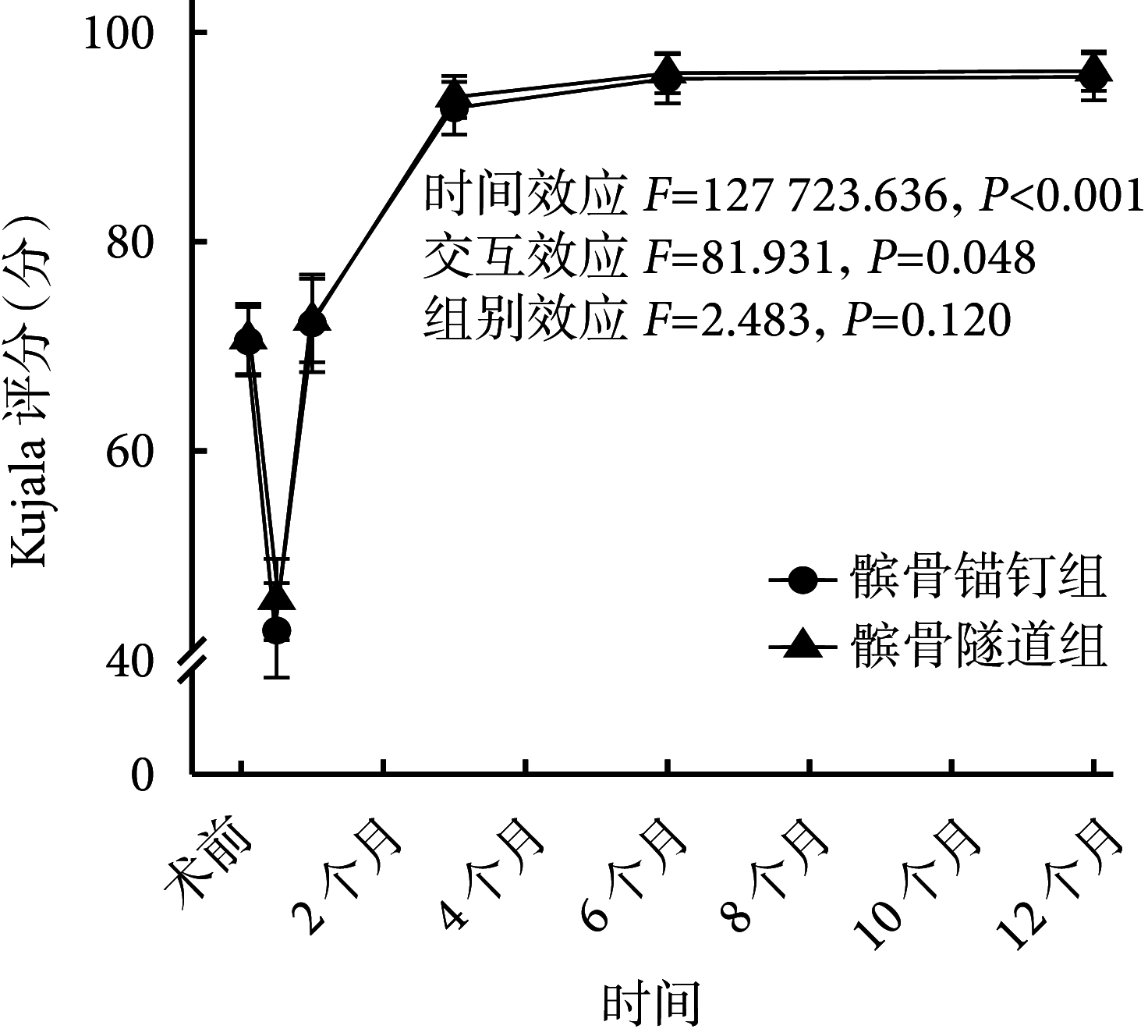[Effectiveness of modified single patellar tunnel medial patella femoral ligament reconstruction for recurrent patellar dislocation]
- PMID: 39848711
- PMCID: PMC11757962
- DOI: 10.7507/1002-1892.202409002
[Effectiveness of modified single patellar tunnel medial patella femoral ligament reconstruction for recurrent patellar dislocation]
Abstract
Objective: To investigate the effectiveness of modified single patellar tunnel medial patella femoral ligament (MPFL) reconstruction in the treatment of recurrent patellar dislocation.
Methods: Between January 2023 and June 2023, a total of 61 patients with recurrent patellar dislocation who underwent MPFL reconstruction with autologous semitendinosus were enrolled and divided into 2 groups using random number table method. In the patellar anchor group, 31 patients were treated with MPFL reconstruction with double medial patellar anchors, and 30 patients in the patellar tunnel group were treated with MPFL reconstruction with single patellar tunnel. The femoral ends of both groups were fixed with absorbable compression screws. There was no significant difference in baseline data such as gender, age, side, tibial tubercle-trochlear groove (TT-TG), Q angle, Caton-Deschamps index, number of dislocation, and preoperative Kujala score, preoperative patellar inclination angle ( P>0.05). Patellar tunnel, patellar anchor position, patellar reduction, and the patellar inclination angle were measured by CT scan after operation. Kujala score was used to evaluate the function of knee joint before operation, at 2 weeks and 1, 3, 6, 12 months after operation. Incision aesthetic satisfaction score was performed at 3 months after operation. The signal-to-noise quotient (SNQ) of the transplanted tendon was measured by knee MRI at 12 months after operation to compare the maturity of the graft between the two groups.
Results: There was no significant difference in operation time and intraoperative blood loss between the two groups ( P>0.05). Knee CT reexamination showed that the patellar tunnel and the patellar anchor position were consistent with the intraoperative fluoroscopy. There was no significant difference in the difference of the patellar inclination angle between the two groups before and after operation ( P>0.05). All patients were followed up 12-14 months (mean, 12.8 months). There was 1 case of patellar anchor suture rejection in patellar anchor group, and the wound healed after debridement and dressing change. During the follow-up, there was no complication such as recurrence of patellar dislocation, infection and postoperative stiffness. The Kujala scores of the two groups significantly improved at each time point after 1 month of operation when compared with those before operation ( P<0.05), and the Kujala scores of the two groups returned to normal levels at 3 months after operation. The Kujala score in the patellar tunnel group was significantly higher than that in the patellar anchor group in the very early stage (2 weeks) ( P<0.05), and there was no significant difference between the two groups at other time points ( P>0.05). Patients in the patellar tunnel group were significantly better than those in the patellar anchor group in the score of incision aesthetic satisfaction at 3 months after operation and the SNQ at 12 months after operation ( P<0.05).
Conclusion: Modified single patellar tunnel MPFL reconstruction was used to treat patients with recurrent patellar dislocation without pathological TT-TG. The slide-fixation structure formed by single patellar tunnel positioning provides a variable degree of freedom for the reconstructed MPFL, which shows good effectiveness in the very early stage of the rehabilitation process.
目的: 探讨改良式髌骨单隧道内侧髌股韧带(medial patella femoral ligament,MPFL)重建治疗复发性髌骨脱位的临床疗效。.
方法: 2023年1月—6月,共纳入61例拟行自体半腱肌重建MPFL治疗的复发性髌骨脱位患者,按随机数字表法分成2组,31例采用髌骨内侧双锚钉MPFL重建(髌骨锚钉组),30例采用髌骨单隧道MPFL重建(髌骨隧道组),两组股骨端均采用可吸收挤压螺钉固定。两组患者性别、年龄、侧别、胫骨结节至滑车沟距离(tibial tubercle-trochlear groove,TT-TG)、Q角、Caton-Deschamps指数、脱位次数及术前Kujala评分、术前髌骨倾斜角等基线资料比较差异均无统计学意义( P>0.05)。术后复查膝关节CT观察髌骨骨道、髌骨锚钉位置及髌骨复位情况,同时测量髌骨倾斜角;术前,术后2周及1、3、6、12个月采用Kujala评分评估膝关节功能恢复情况;术后3个月行切口美观满意度评分;术后12个月复查膝关节MRI测量移植肌腱信噪比(signal-to-noise quotient,SNQ)比较两组患者移植物的成熟度。.
结果: 两组手术时间、术中出血量比较差异无统计学意义( P>0.05)。膝关节CT复查示髌骨骨道、髌骨锚钉位置与术中透视定位一致;两组髌骨倾斜角手术前后差值比较差异无统计学意义( P>0.05)。两组患者均获随访,随访时间12~14个月,平均12.8个月。髌骨锚钉组有1例髌骨端锚钉缝线排斥反应,经清创换药后切口愈合。随访期间患者均无髌骨脱位复发、感染、术后僵硬等相关并发症发生。两组患者术后1个月后各时间点Kujala评分均较术前显著改善( P<0.05),术后3个月均恢复至正常水平。术后极早期(2周时)髌骨隧道组Kujala评分高于髌骨锚钉组,差异有统计学意义( P<0.05),其余时间点两组间比较差异均无统计学意义( P>0.05)。髌骨隧道组患者术后3个月切口美观满意度评分及术后12个月SNQ显著优于髌骨锚钉组( P<0.05)。.
结论: 采用改良式髌骨单隧道MPFL重建治疗不伴病理性TT-TG的复发性髌骨脱位患者,髌骨单隧道定位方式形成的髌骨端滑动-固定结构为重建的MPFL提供了一个可变自由度,在康复极早期展现了很好的临床疗效。.
Keywords: Medial patella femoral ligament reconstruction; patellar tunnel; recurrent patellar dislocation.
Conflict of interest statement
利益冲突 在课题研究和文章撰写过程中不存在利益冲突;经费支持没有影响文章观点和对研究数据客观结果的统计分析及其报道
Figures
Similar articles
-
Decreased Association Between Patellar Axial Malalignment and Patellar Height and Increased Association Between Patellar Axial Malalignment and Tibial Tubercle-Trochlear Groove During Weightbearing.Clin Orthop Relat Res. 2025 Jun 1;483(6):1096-1109. doi: 10.1097/CORR.0000000000003357. Epub 2025 Jan 21. Clin Orthop Relat Res. 2025. PMID: 39842005
-
Robot-Assisted Medial Patellofemoral Ligament Reconstruction in the Treatment of Recurrent Patellar Dislocation Can Improve Tunnel Accuracy but Yields Similar Outcome Compared With Traditional Technique.Arthroscopy. 2025 Aug;41(8):2999-3009. doi: 10.1016/j.arthro.2025.01.012. Epub 2025 Jan 23. Arthroscopy. 2025. PMID: 39862937
-
Midterm Outcomes of Medial Patellofemoral Ligament Reconstruction in Adolescent Athletes: Comparison Between Acute and Recurrent Patella Dislocation.J Clin Med. 2025 Jul 9;14(14):4881. doi: 10.3390/jcm14144881. J Clin Med. 2025. PMID: 40725574 Free PMC article.
-
Results of medial patellofemoral ligament reconstruction compared with trochleoplasty plus individual extensor apparatus balancing in patellar instability caused by severe trochlear dysplasia: a systematic review and meta-analysis.Knee Surg Sports Traumatol Arthrosc. 2017 Dec;25(12):3869-3877. doi: 10.1007/s00167-016-4365-x. Epub 2016 Oct 27. Knee Surg Sports Traumatol Arthrosc. 2017. PMID: 27796419
-
Medial patellofemoral ligament reconstruction using patella bone tunnel techniques with or without implants. A systematic review of outcomes and complications.Eur J Orthop Surg Traumatol. 2023 Dec;33(8):3225-3234. doi: 10.1007/s00590-023-03559-1. Epub 2023 May 1. Eur J Orthop Surg Traumatol. 2023. PMID: 37127815
References
-
-
Frosch S, Balcarek P, Walde TA, et al. The treatment of patellar dislocation: a systematic review. Z Orthop Unfall, 2011, 149(6): 630-645.
-
-
- Straume-Næsheim TM, Randsborg PH, Mikaelsen JR, et al Medial patellofemoral ligament reconstruction is superior to active rehabilitation in protecting against further patella dislocations. Knee Surg Sports Traumatol Arthrosc. 2022;30(10):3428–3437. doi: 10.1007/s00167-022-06934-3. - DOI - PMC - PubMed
Publication types
MeSH terms
LinkOut - more resources
Full Text Sources
Medical
Miscellaneous




